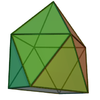|
Gyroelongated pyramid
In geometry, the gyroelongated pyramids (also called augmented antiprisms) are an infinite set of polyhedra, constructed by adjoining an n-gonal pyramid to an n-gonal antiprism. There are two gyroelongated pyramids that are Johnson solids made from regular triangles and square, and pentagons. A triangular and hexagonal form can be constructed with coplanar faces. Others can be constructed allowing for isosceles triangles. Forms
See alsoReferences
|
|||||||||||||||||||||||||||||||




